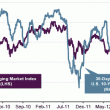The Crucial Connection: Asset Allocation & Rebalancing
The link between asset allocation and rebalancing is widely recognized, but it’s not always widely respected. This is a subtle point, but it has major implications for risk management and earning a respectable risk premium through time. Most investors understand this, at least intuitively. But in practice, it’s not unusual to see portfolio designs that are victimized by what I call subjective neglect.
The key issue here is a simple empirical fact: the decisions for the initial asset allocation dictate what’s possible, and what’s not, with the all-important task of rebalancing. As a ridiculously extreme example, imagine a portfolio that’s equally weighted across 10 assets. On first blush, this looks like a productive framework. Maybe, but the outlook for this portfolio is a complete mystery until we see the choices for the 10 assets. If the choices are various pieces of the US equity market—large-cap value, small-cap value, large-cap growth, small-cap growth, etc.—the expected rebalancing opportunity would be substantially different compared with holding 10 assets that tracked different slices of the major asset classes.
Yes, it's obvious that the example above is deficient. But actual portfolios are more subtle, with allocations that appear to be more diversified than they really are. As a result, it's not always obvious how a given portfolio design is less than it could be or should be with respect to maximizing the rebalancing potential.
The bottom line here is that your choice of assets for the portfolio will dominate the degree and depth of the rebalancing opportunity through time. This is no trivial point. In fact, we can think of the initial asset allocation as a rebalancing decision since the former will largely define the outcome of the latter. But here’s where some investors stumble. There tends to be a fair amount of bias in choosing asset classes. One that’s fairly well known is the home bias—favoring a heavy weighting of domestic assets, and for reasons that have less to do with objective analysis vs. your address.
Maintaining a healthy degree of objectivity is unusually difficult in matters of investing. That’s hard for some folks to fathom because they’re consuming most if not all of their investment intelligence by reading headlines and watching TV shows that excel only in drama and the narrative du jour. But if we look at asset allocation and rebalancing as more of an engineering challenge, we might start from the perspective of considering the full range of possibilities and intelligently paring the list, if at all, from that starting point.
From there, how should we make decisions on portfolio design? One might begin from a simple premise of what we know:
* rebalancing is the crucial factor for determining risk and return over time
* the initial choice of asset allocation will define the range of potential outcomes with rebalancing.
These two fundamental facts strongly imply that we should consider all the major asset classes as a starting point for portfolio design. Perhaps the first question is how to carve up the individual pieces, a decision process that’s driven by a range of issues. What are the choices for ETFs and mutual funds? What does history and the financial literature tell us about granular definitions for any one asset class?
What you shouldn’t do is exclude an asset class simply because you don’t know much about it or don't hear anyone on TV pumping up its prospects for stellar returns. There are several good reasons for customizing Mr. Market’s asset allocation, but casual, subjective indifference to some of the components of the global markets isn’t one of them.
Ultimately, you should think of what you may be giving up if your portfolio excludes certain asset classes. I sometimes hear complaints that investors have become over-diversified in recent years. That’s certainly possible, but the details matter. It’s hard to argue that you’re over-diversified if your portfolio is spread across the major asset classes. In my experience, I’ve found that the opposite problem tends to pop up more frequently: under-diversification across asset classes. This is really a problem about rebalancing. If you don’t see the connection, you may be setting yourself up for trouble down the road.















